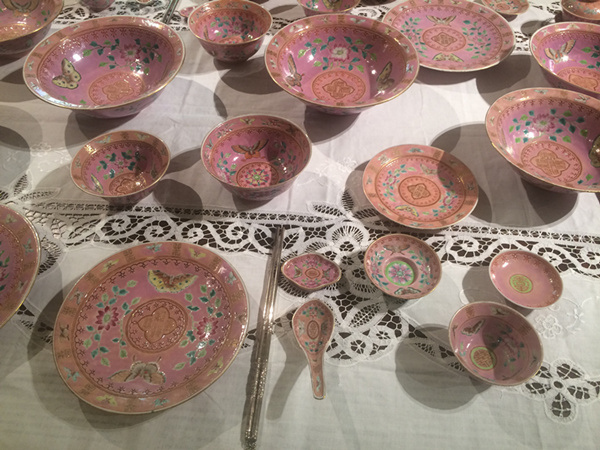Hybrid culture in a red dot
Updated: 2015-03-07 07:56
By Wang Chao(China Daily)
|
|||||||||||
 |
|
A set of the Peranakan-style kitchen wares. [Photo by Wang Chao/China Daily] |
The wedding decorations were all about bling - crowns for husband and wife were made by gold, gem and diamond, and even tablecloths were made from sparking bead embroidery. These tablecloths were made by thousands of tiny glass beads to form various auspicious patterns such as birds, peanuts, dates, and flowers. In the Peranakan culture, to have a happy marriage, these tablecloths were supposed to be made by the girl herself - probably since she could pick up a needle.
The guide in the museum told me that the Peranakan tradition is reviving. Ten years ago, nobody said he was a Peranakan, but nowadays, people all claim that have a certain Peranakan blood. Now being Peranakan is trendy. "After the museum opened, many young couples came to consult us about the Peranakan-style wedding, which was almost extinct decades ago," the guide said.
For those interest in local culture, the Waterloo Street is a must-go. Here you can see the amazing scene of an Indian temple Sri Krishnan Temple and Chinese Kwan Im Thong Hood Cho Temple siting side by side.
Strolling on the street, I passed stands and stands of fresh lotuses and chrysanthemums, which are sold to worship the deities. First I saw the colorful Indian temple, with the sculptures of two Indian gods guarding the gate. But strangely enough there are incense burners in front of the gate, which is a typical Buddhist practice.
The guide told me there were no incense burners outside the gate initially, but every morning when the Indians are worshipping, Chinese passers-by stop and burn incense outside to pay their tribute, and leave the ashes on the ground.
"People here are not exclusive in religion, whenever they see a temple or a church, they pay their tribute," the guide said.
The Kwan Im Thong Hood Cho Temple is the most powerful temple in Singapore, and it will make every wish come true, according to the introductions. Here I spent four Singapore dollars to buy a small bouquet, and made a wish inside the hall.
The next day I visited a traditional dragon kiln called Thow Kwang. The 20-meter-long kiln is built on a slop so when the fire is lit on the fire box, the hot air can rise all the way through the stretched kiln and heat the glazed pots placed in the kiln. The kiln is so large that each time 2,000 pieces of ceramics can be made.
The kiln was traditionally used to make Peranakan Chinese ceramics. But today the kiln has lost its original function and has become a gathering place for Singaporean artists to create something unpredictable.
Today electric kilns are widely adopted, but the dragon kiln is still the favorite of many artists. The flame generated by the wood and the ashes can give a magical tint to the glaze, and the unexpected effect is most exciting thing to see.
Related Stories
Preview of 2015 Chingay Parade held in Singapore 2015-02-27 10:14
Singapore's Chinatown holds light up ceremony for Lunar New Year 2015-02-02 07:07
Lion dance competition held in Singapore's Chinatown 2015-02-08 09:44
Stars shine at Singapore Int'l Film Festival 2014-12-08 07:00
Singaporean abroad 2014-11-26 09:08
Today's Top News
China likely to maintain 7% growth for 20 years
Moscow releases last Chinese detained for alleged drug trafficking
Chinese to buy islands online
Two major train makers to merge
Finance Minister: no spending spree
Bright Food continues with overseas expansion
China lowers annual GDP growth target to 7%
China faces 'formidable challenges'
Hot Topics
Lunar probe , China growth forecasts, Emission rules get tougher, China seen through 'colored lens', International board,
Editor's Picks

|

|

|

|

|

|





